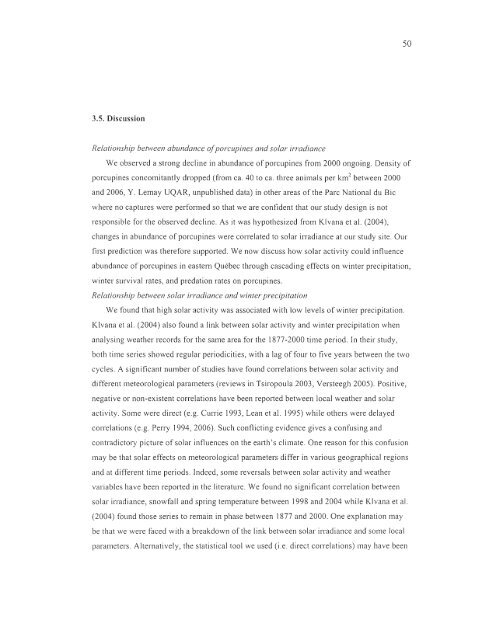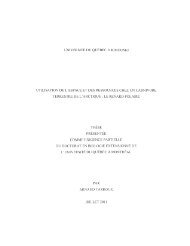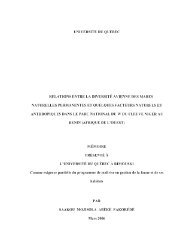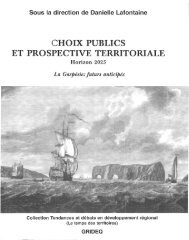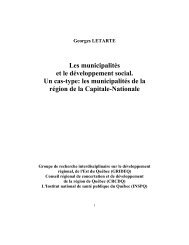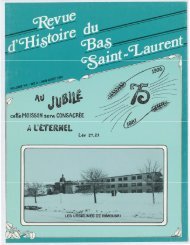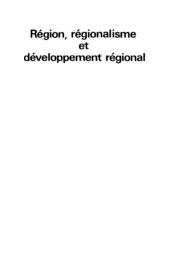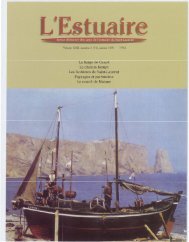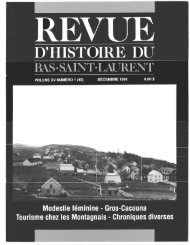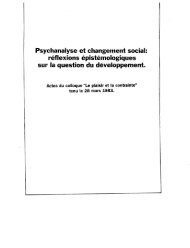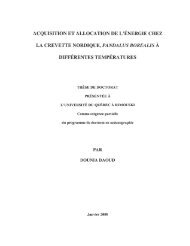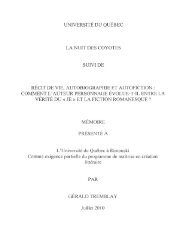influence du climat et de la prédation sur l'utilisation de l'habitat et la ...
influence du climat et de la prédation sur l'utilisation de l'habitat et la ...
influence du climat et de la prédation sur l'utilisation de l'habitat et la ...
Create successful ePaper yourself
Turn your PDF publications into a flip-book with our unique Google optimized e-Paper software.
50<br />
3.5. Discussion<br />
Re<strong>la</strong>tionship b<strong>et</strong>ween abundance of porcupines and so<strong>la</strong>r irradiance<br />
We observed a strong <strong>de</strong>cline in abundance of porcupines from 2000 ongoing. Density of<br />
porcupines concomitantly dropped (from ca. 40 to ca. three animaIs per km 2 b<strong>et</strong>ween 2000<br />
and 2006, Y. Lemay UQAR, unpublished data) in other areas of the Parc National <strong>du</strong> Bic<br />
where no captures were performed so that we are confi<strong>de</strong>nt that our study <strong>de</strong>sign is not<br />
responsible for the observed <strong>de</strong>c\ine. As it was hypothesized from Klvana <strong>et</strong> al. (2004),<br />
changes in abundance of porcupines were corre<strong>la</strong>ted to so<strong>la</strong>r irradiance at our study site. Our<br />
first prediction was therefore supported. We now discuss how so<strong>la</strong>r activity could <strong>influence</strong><br />
abundance of porcupines in eastern Québec through cascading effects on winter precipitation,<br />
win ter <strong>sur</strong>vival rates, and predation rates on porcupines.<br />
Re<strong>la</strong>tionship b<strong>et</strong>ween so<strong>la</strong>r irradiance and winter precipitation<br />
We found that high so<strong>la</strong>r activity was associated with low levels of winter precipitation.<br />
Klvana <strong>et</strong> al. (2004) also found a link b<strong>et</strong>ween so<strong>la</strong>r activity and winter precipitation when<br />
analysing weather records for the same area for the 1877-2000 time period. In their study,<br />
both time series showed regu<strong>la</strong>r periodicities, with a <strong>la</strong>g of four to five years b<strong>et</strong>ween the two<br />
cycles. A significant number of studies have found corre<strong>la</strong>tions b<strong>et</strong>ween so<strong>la</strong>r activity and<br />
different m<strong>et</strong>eorological param<strong>et</strong>ers (reviews in Tsiropou<strong>la</strong> 2003, Versteegh 2005). Positive,<br />
negative or non-existent corre<strong>la</strong>tions have been reported b<strong>et</strong>ween local weather and so<strong>la</strong>r<br />
activity. Sorne were direct (e.g. Currie 1993, Lean <strong>et</strong> al. 1995) white others were <strong>de</strong><strong>la</strong>yed<br />
corre<strong>la</strong>tions (e.g. Perry 1994, 2006). Such conflicting evi<strong>de</strong>nce gives a confusing and<br />
contradictory picture of so<strong>la</strong>r <strong>influence</strong>s on the earth 's <strong>climat</strong>e. One reason for this confusion<br />
may be that so<strong>la</strong>r effects on m<strong>et</strong>eorological param<strong>et</strong>ers differ in various geographical regions<br />
and at different time periods. In<strong>de</strong>ed, sorne reversaIs b<strong>et</strong>ween so<strong>la</strong>r activity and weather<br />
variables have been reported in the literature. We found no significant corre<strong>la</strong>tion b<strong>et</strong>ween<br />
so<strong>la</strong>r irradiance, snowfall and spring tempe rature b<strong>et</strong>ween 1998 and 2004 white Klvana <strong>et</strong> al.<br />
(2004) found those series to remain in phase b<strong>et</strong>ween 1877 and 2000. One exp<strong>la</strong>nation may<br />
be that we were faced with a breakdown of the link b<strong>et</strong>ween so<strong>la</strong>r irradiance and sorne local<br />
param<strong>et</strong>ers. Alternatively, the statistical tool we used (i .e. direct corre<strong>la</strong>tions) may have been


